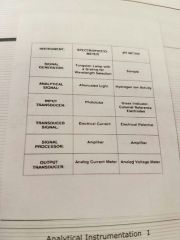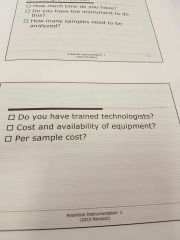![]()
![]()
![]()
Use LEFT and RIGHT arrow keys to navigate between flashcards;
Use UP and DOWN arrow keys to flip the card;
H to show hint;
A reads text to speech;
46 Cards in this Set
- Front
- Back
|
Analytical instrumentation is; |
Using an instrument to analyze the chemical composition and amount in a given sample |
|
|
Analytical chemistry |
-deals with identifying the chemical makeup and quantities in a sample by either; classic or instrumental |
|
|
Qualitative analytical chemistry |
Identify what's in our sample |
|
|
Quantitative analytical chemistry |
We want to know the quantity -how much is in our sample |
|
|
Classical method |
-also called wet chemistry -quantify and identify the sample without using instruments |
|
|
Methods used to identify the sample |
Precipitation Extraction Distillation |
|
|
Reagents are used to identify the sample by; |
Color Melting point Boiling point Ordors Solubility Optical activity Refractive Index
|
|
|
Instrumental method is; |
-used to separate, identify and quantify a sample
|
|
|
Some physical properties that could be used to identify a component in a sample are; |
Conductivity Electrode potential Light absorption or emission Fluorescence |
|
|
Analyte |
Substance you're looking for |
|
|
Ways to get the information about the physical or chemical characteristics of a sample; |
A stimulus is needed in the former of electrical, mechanical, electromagnetic or nuclear energy |
|
|
Data Domains |
-transferring information from one form to another electrically |
|
|
Nonelectrical data Domain |
nonelectrical doesn't need to be transferred because technician understands the information |
|
|
Electrical data Domain subdivisions |
-3 domains analog domain Time domain Digital domain |
|
|
Analytical instrument |
Any device that measures a chemical or physical property either directly or indirectly - can be electrical or mechanical |
|
|
6 instrumental methods |
1. Spectral method 2. Electroanalytical methods 3. Separative methods 4. Thermal methods 5. Energetic particle method 6. Mass methods |
|
|
Spectral method |
Use some form of electromagnetic radiation -uses absorption, emission and scattering of light Examples -Spectrophotometry -Emission methods: fluorescence, phosphorescence, luminescence -nuclear magnetic resonance -Polarimetry -X-ray diffraction |
|
|
Electroanalytical methods |
Measure some form of electrical property of the sample -uses potential, current, resistance Examples -potentiometry - electrogravimetry - coulometry - conductometry - voltammetry |
|
|
Separative methods |
Employ physical and chemical interactions to separate components in a sample -uses absorption, partitioning, ion exchange, size exclusion Examples - gas chromatography - liquid chromatography - electrophoresis
|
|
|
Thermal methods |
Measure heat changes that have to do with chemical or physical processes -use temperature and heat Examples -thermogravimetry -differential thermal analysis -Differential scanning calorimetry - thermometric titrations
|
|
|
Energetic particle methods |
Generate or measure particles emanating from the sample -uses alpha particles, beta particles, ion in gas phase Examples - mass spectrometry - radiochemical methods - nuclear activation analysis |
|
|
Mass methods |
Measures mass changes associated with chemical or physical processes |
|
|
4 basic components in any instrument |
1. A signal generator 2. An input transducer (detector) 3. A signal processor 4. An output transducer (readout) |
|
|
Signal generator |
Can be the sample itself or a device that excites the sample that makes a change in the analytical signal Processing -sample : will passively respond to the chemistry -device : will actively change the sample |
|
|
Input transducers |
Transducer: converts one type of information into another ( from electrical to nonelectrical and vice versa) Input: converts information from nonelectrical domains to electrical domains Examples - thermocouples ; temp to voltage - phototube; radiant power to electrical current -electrode; ion activity to electric voltage |
|
|
Signal processors |
Converts output from the detector to a form that is suitable for use by the output transducer Examples - filtration - integration - rectification |
|
|
Output transducer |
Converts information from electrical to nonelectrical domains |
|

|
Table |
|
|
Things to consider when choosing an analytical method |
1. How much accuracy is required 2. How much sample is available 3. What is the concentration range of the analyte 4. What components of the sample may cause interference 5. What are the physical and chemical properties of the sample electrode |
|
|
Other things to consider when selecting an analytical method |

|
|
|
Precision |
The amount of scatter in your data -duplicate analysis is done on the sample to carry out statistical tests |
|
|
Bias |
Measures the accuracy because in - provides a measure of the error in an analysis |
|
|
Sensitivity |
The ability of an instrument or method to Discriminate between small difference in concentration. |
|
|
The two factors that limit sensitivity |
1. The slope of the calibration curve 2. The reproducitility or precision of the instrument |
|
|
Calibration sensitivity |
The slope of the calibration curve ( its the m in y=mx + b) |
|
|
Analytical sensitivity |
Y=m÷Ss ( m is the slope and Ss is the standard deviation) |
|
|
Detection limit |
Minimum concentration or mass of analyte that can be detected at a known confidence level Cm= minimum concentration Sm=minimum signal 1. Use Sm=Sbl+ksbl where k=3, S=average signal, s=standard deviation and bl= the given standard 2. After use Cm= Sm-Sbl/m where Sm=minimum signal, Sbl= average signal of the given standard and m=slope |
|
|
Coefficient variation |
CV=s÷S x100 where s=standard deviation of given and S=average signal |
|
|
Relative standard deviation (RSD) |
RSD=s/S where s=standard deviation and S=average signal |
|
|
Variance |
s2- standard deviation squared |
|
|
Signal to noise ratio |
The reciprocal of RSD S/N= S/s where S=average signal and s=standard deviation |
|
|
Signal detection rule |
It is impossible to detect a signal when noise ratio is less than 2 or 3 |
|
|
Sources of noise in an instrumental analysis |
Chemical noise Instrumental noise |
|
|
Types of instrumental noise |
Thermal noise Shot noise Flicker noise Environmental noise |
|
|
The two areas where frequency does not appear to generate much of this environmental noise |
3 to 6 Hz 1 to 500 kHz |
|
|
Signal-to-noise enhancement |
-want a large signal to noise ratio which would mean that our noise is small -can use hardware and software methods to improve the ratio or lower the noise |

